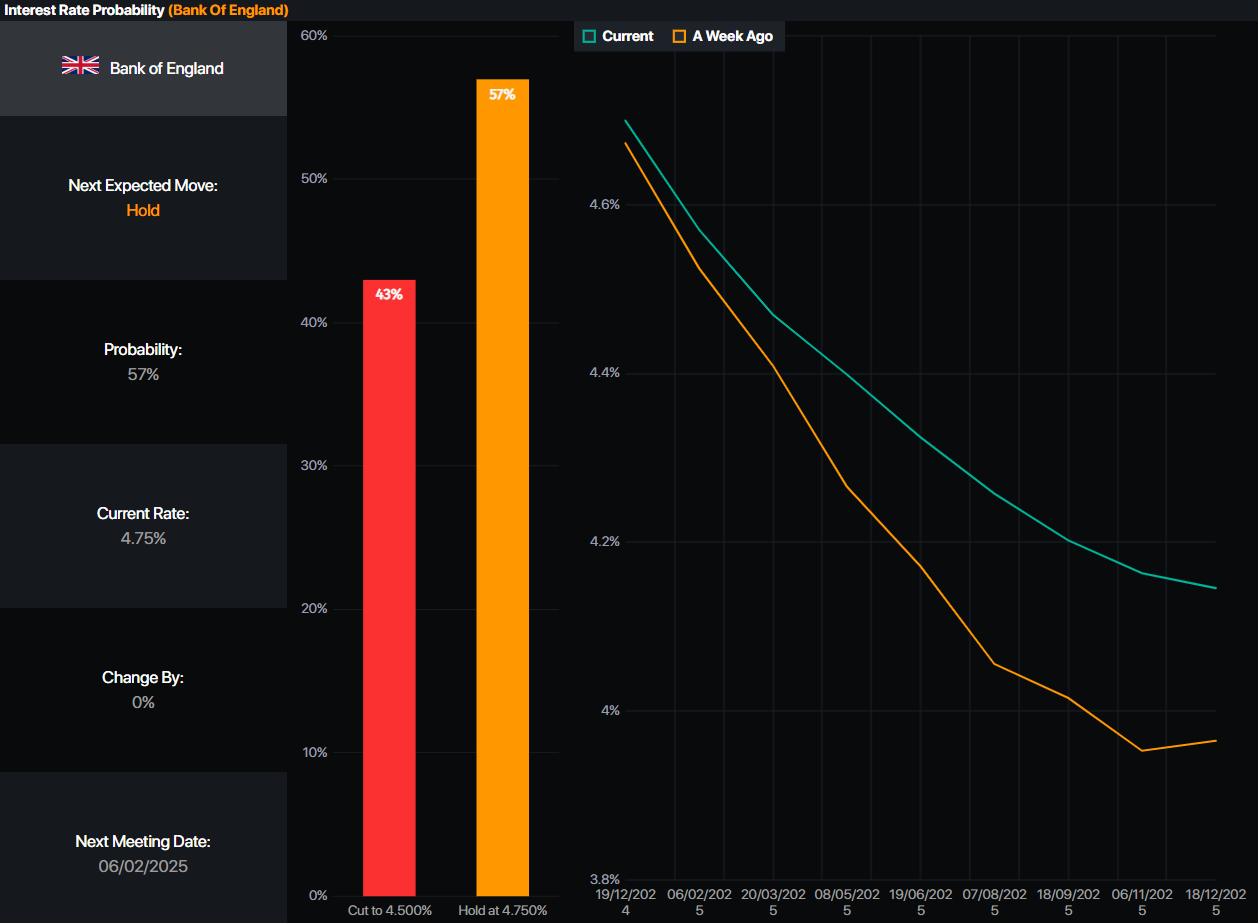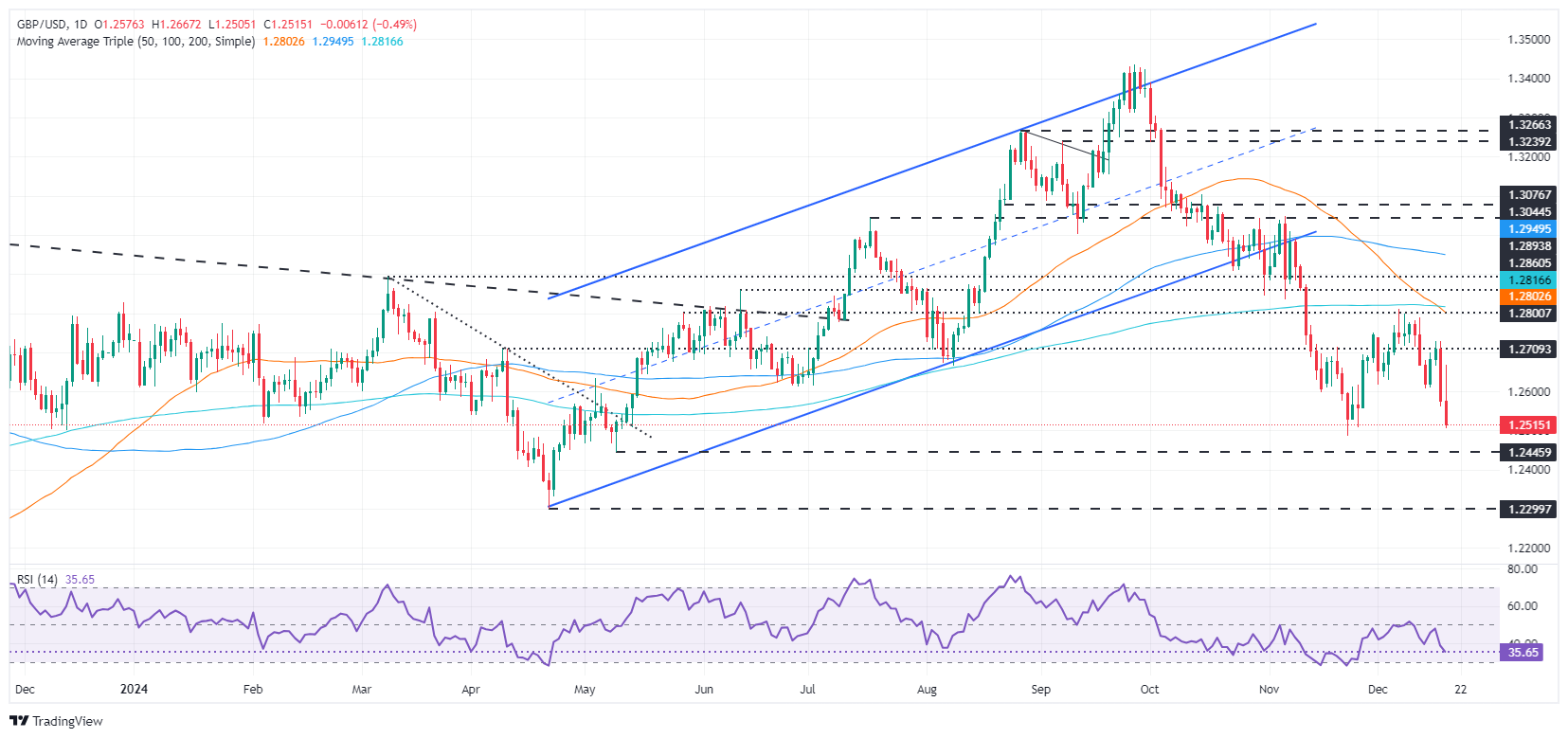GBP/USD tumbles near 1.2500 breakdown as US data boosts USD
- GBP/USD drops over 60 pips, pressured by robust US job and GDP reports, flirting with the 1.2500 threshold.
- US 10-year Treasury yield climbs seven bps to 4.592%, reinforcing dollar strength against the British Pound.
- BoE holds interest rate steady in a split decision, with mixed expectations for future rate adjustments in early 2025.
The GBP/USD extended its losses during the North American session, with sellers targeting a break below 1.2500. Cable is losing over 0.48% or 60 pips on the day. At the time of writing, the pair hovers near 1.2500.
Cable declines sharply amid strong US economic data and rising Treasury yields
US data released ahead of the New York open hinted that the labor market remains solid and the economy is expanding. Initial Jobless Claims for the week ending December 14 fell from 242K to 220K, below forecasts of 230K.
At the same time, the US Bureau of Economic Analysis (BEA) revealed that the Gross Domestic Product in Q3 ended at 3.1%, above estimates of 2.8% and up from 3% in Q2.
Earlier, the Bank of England (BoE) left rates unchanged at 4.75% in a 6-3 vote split. At the time of writing, the odds that the BoE will hold rates in February 2025 stand at 57%, while for a quarter of a percentage point rate cut, chances are at 43%.

Source: Prime Market Terminal
Lately, the GBP/USD has extended its losses as US Treasury yields soared, with the 10-year T-note yielding up seven basis points (bps) at 4.592%. This underpins the Greenback, as seen by the US Dollar Index (DXY), gaining 0.24% at 108.45.
GBP/USD Price Forecast: technical outlook
The GBP/USD is falling rapidly towards testing the November 22 low of 1.2486. In that outcome, sellers would not have anything on the way ahead of the April 22 low of 1.2299. Conversely, if GBP/USD stays above 1.2500, buyers could target 1.2600, ahead of challenging the daily high of 1.2664. On further strength, the December 17 high of 1.2728 would be up next.

Pound Sterling FAQs
The Pound Sterling (GBP) is the oldest currency in the world (886 AD) and the official currency of the United Kingdom. It is the fourth most traded unit for foreign exchange (FX) in the world, accounting for 12% of all transactions, averaging $630 billion a day, according to 2022 data. Its key trading pairs are GBP/USD, also known as ‘Cable’, which accounts for 11% of FX, GBP/JPY, or the ‘Dragon’ as it is known by traders (3%), and EUR/GBP (2%). The Pound Sterling is issued by the Bank of England (BoE).
The single most important factor influencing the value of the Pound Sterling is monetary policy decided by the Bank of England. The BoE bases its decisions on whether it has achieved its primary goal of “price stability” – a steady inflation rate of around 2%. Its primary tool for achieving this is the adjustment of interest rates. When inflation is too high, the BoE will try to rein it in by raising interest rates, making it more expensive for people and businesses to access credit. This is generally positive for GBP, as higher interest rates make the UK a more attractive place for global investors to park their money. When inflation falls too low it is a sign economic growth is slowing. In this scenario, the BoE will consider lowering interest rates to cheapen credit so businesses will borrow more to invest in growth-generating projects.
Data releases gauge the health of the economy and can impact the value of the Pound Sterling. Indicators such as GDP, Manufacturing and Services PMIs, and employment can all influence the direction of the GBP. A strong economy is good for Sterling. Not only does it attract more foreign investment but it may encourage the BoE to put up interest rates, which will directly strengthen GBP. Otherwise, if economic data is weak, the Pound Sterling is likely to fall.
Another significant data release for the Pound Sterling is the Trade Balance. This indicator measures the difference between what a country earns from its exports and what it spends on imports over a given period. If a country produces highly sought-after exports, its currency will benefit purely from the extra demand created from foreign buyers seeking to purchase these goods. Therefore, a positive net Trade Balance strengthens a currency and vice versa for a negative balance.